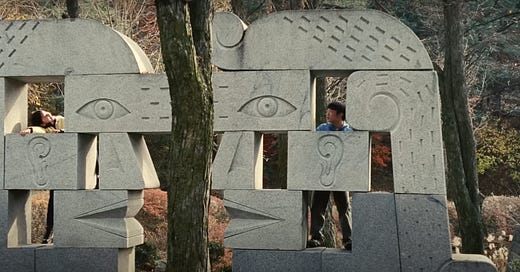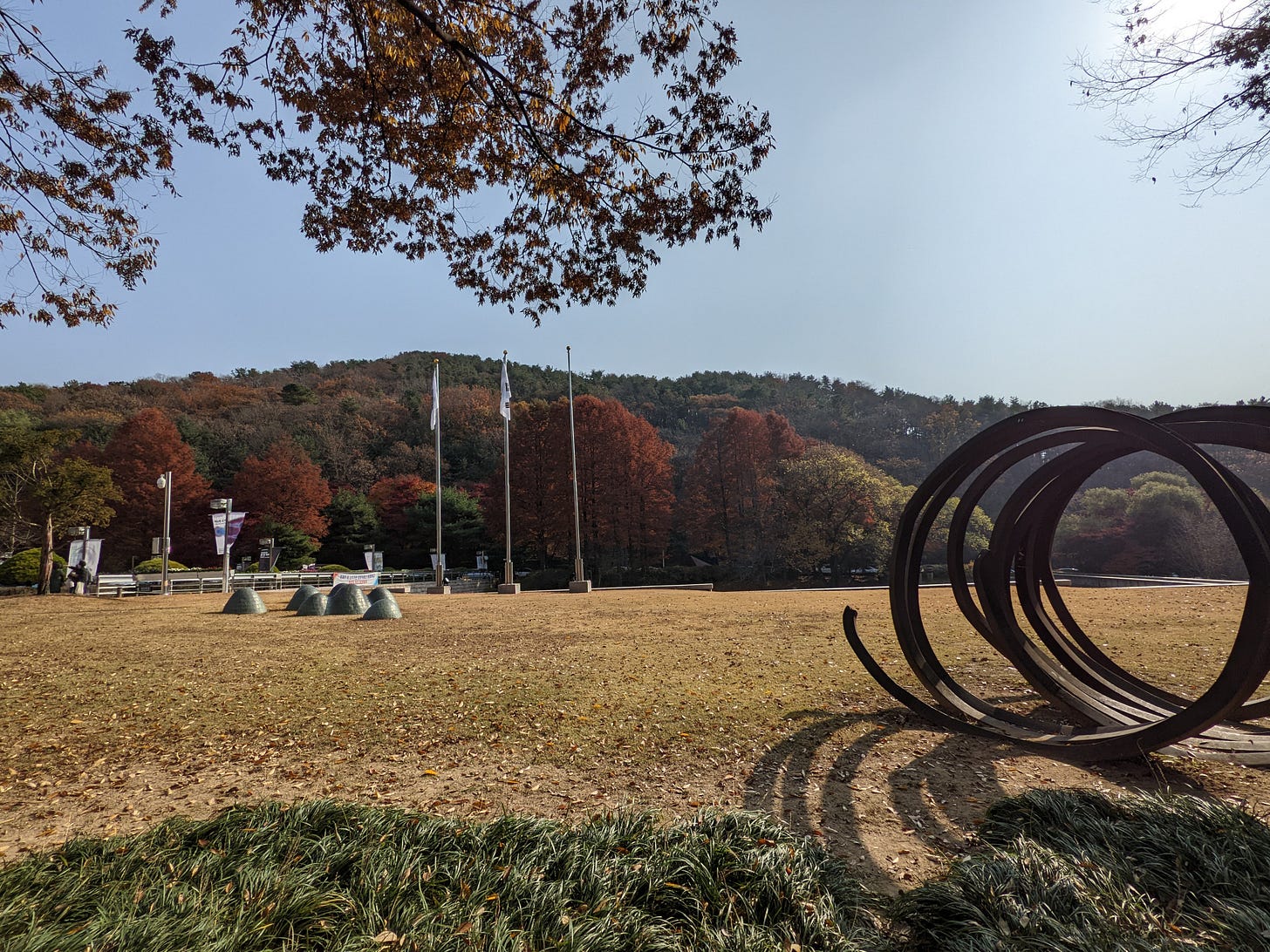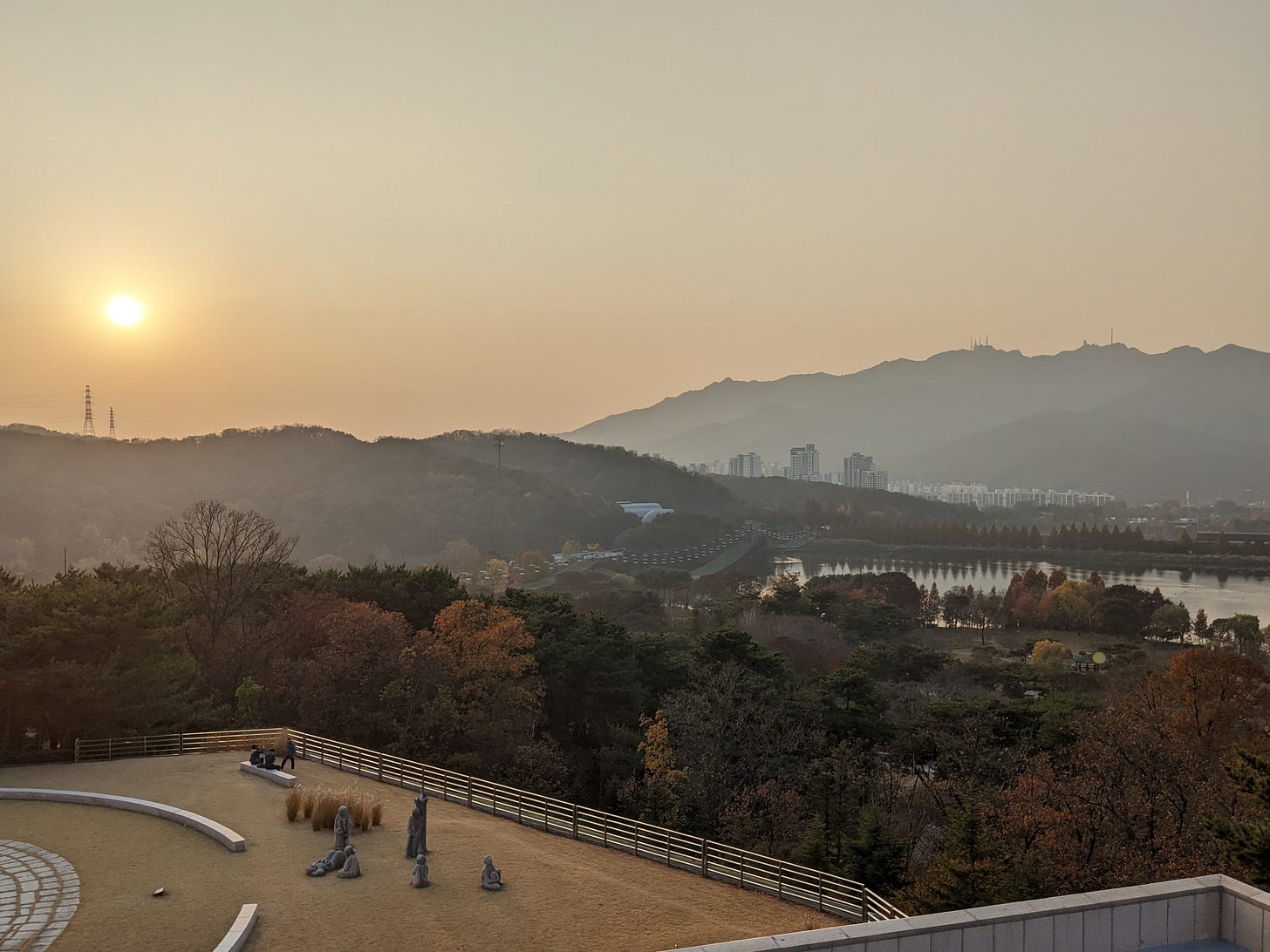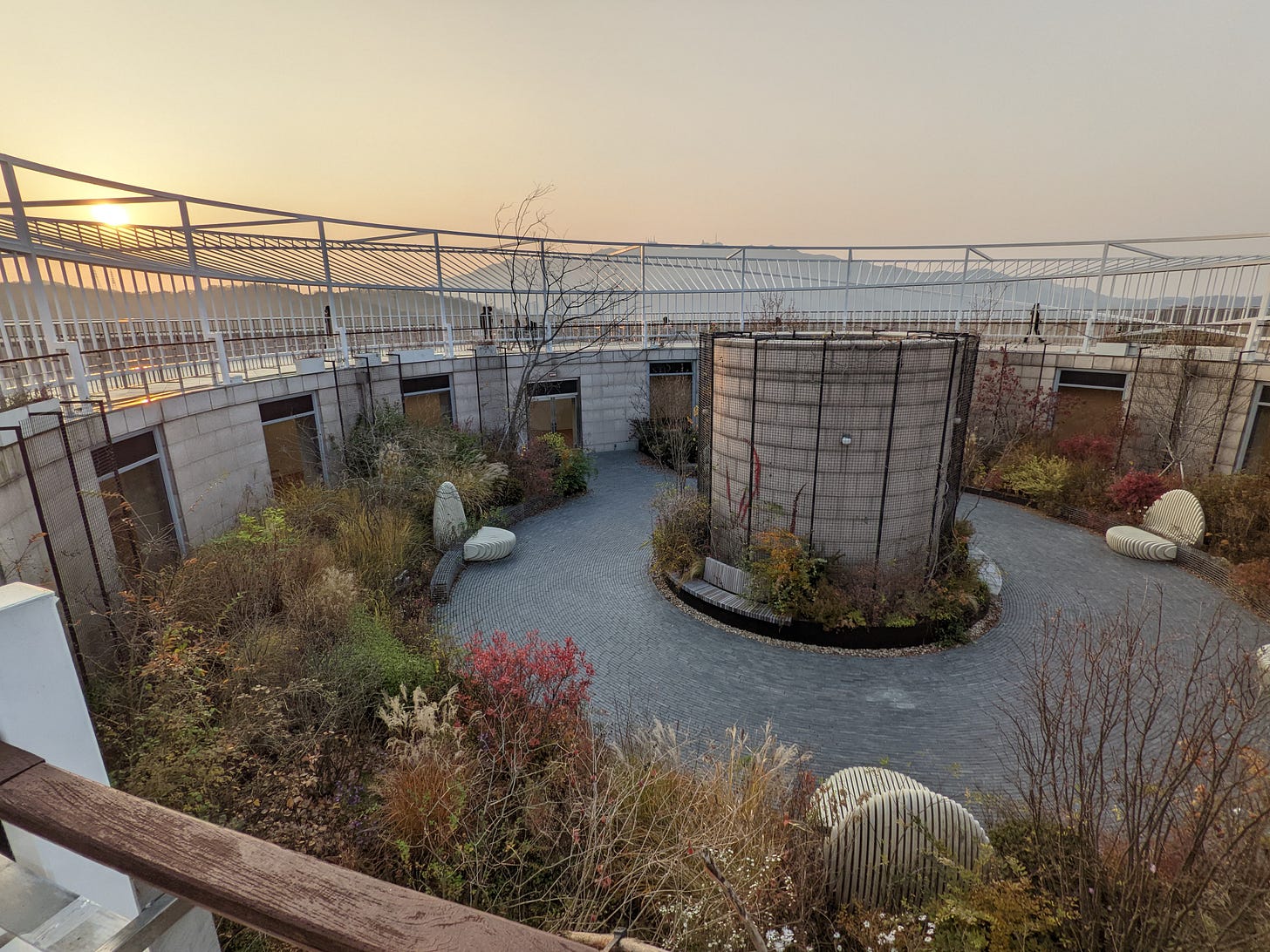Past Lives Finds a Moment of Peace and Eternity at a Korean Art Museum
The characters spend the day at the Museum of Modern and Contemporary Art Gwacheon, with some very apt works of art...
"If two strangers walk by each other on the street and their clothes accidentally brush, that means there have been 8000 layers of 'in-yun' between them."
-Nora, Past Lives
In the first act of Celine Song’s debut film Past Lives, childhood sweethearts Nora and Hae Sung spend one last, beautiful day together thanks to Nora’s mother, before they separate for more than a decade. As she tells Hae Sung’s mother, she wanted to give them one last memory together. It’s a perfect little day, a memory trapped in amber just before they part for the unknown, Hae Sung remaining in Korea and Nora heading to Canada along with her family.
They spend the day at the Museum of Modern and Contemporary Art’s Gwacheon branch, a picturesque museum nestled among the hills and trees just south of Seoul. The museum is as much outdoors as indoors, its edges blending softly into its environs, with sculptural bus stops leading the way from public transportation to the museum’s entrance. A circular two-story terrace with a garden and benches on its roof is meant for taking in the view and discussing the art with other patrons, and a sculpture garden greets visitors, wrapping around the grounds surrounding the museum itself like a cape.
I was lucky enough to visit MMCA Gwacheon, as well as the main branch and MMCA Deoksugang Palace while I was in South Korea last fall. MMCA Gwacheon is a peaceful place that feels like it was created in harmony with the land it inhabits. The sculpture garden is a large-scale park (I walked around it for about 30 minutes and I probably should have budgeted more time) with over 80 sculptures. I saw many families with children there, and there’s also a specific children’s museum inside MMCA Gwacheon, so I can see why Nora’s mother chose this museum rather than any others.
The Museum of Modern and Contemporary Art, Gwacheon
If you’ve heard of MMCA Gwacheon before, it’s likely because of “The More, The Better,” Paik Nam June’s towering piece for the 1988 Olympics that holds court in the museum’s rotunda. The video sculpture is over 60 feet tall and was originally made of 1,003 cathode ray tube (CRT) televisions, which visitors can see from all sides as they walk the circular ramps around the outer edge of the rotunda. The piece was recently restored and can now be turned on several times a day, though it now has some flatscreens hiding inside CRT casings among the CRTs, as they’re no longer being manufactured. If you visit the museum, it’s well worth it to ensure you see the piece turned on. Until April 7, 2024, the exhibition Merry Mix, found at the top of the museum, details the creation of The More, The Better, with a wealth of insight into NJP’s process.
I reached out to the folks at the MMCA, and Tiffany Yun, PR representative of MMCA, was kind enough to share some information with me about the museum, the work featured in the film, and the experience with Past Lives.
Jonathan Borofsky’s "singer" (1994)
It’s in the sculpture garden where we see young Nora and Hae Sung, starting with Jonathan Borofsky’s "singer" (1994), the large metal figure from his Hammering Man series, the largest in the series. It’s immediately recognizable to anyone who has been to MMCA Gwacheon, or who has seen a piece in the series. It was made for the 1994 Chicago Art Fair, and it is known as one of Borofsky’s masterpieces. Like many of the Boston-born Mainer’s works, Borofsky’s entire Hammering Man series deals with human labor. Borofsky’s Getty profile describes the printmaker and sculptor’s work as dealing with “diminishing the boundaries between life and art,” which feels apt considering that the setup for Past Lives was inspired by real events in the writer-director’s own life.
Yun describes Borofsky’s work as, “large, surreal, and dreamy,” and says he is, “an artist who has kept his own style, not involved in many other trendy styles of art.”
She continues, “His sculptures have been installed in front of public places and buildings in many cities around the world. He considers the imagination and labor of a man as a kind of creative energy, and such his speculation shapes the base of his art.”
While the series of sculptures is called Hammering Man due to the typical action of the statues, the one in the film undertakes a creative labor instead. “This <Singing Man>(1994) is a MMCA Gwacheon’s symbolic artwork because of its hugeness and cheerful sound. He always welcomes museum visitors at first. The flashing metal man on the blue grass blows trumpets all day long,” Yun says.
She continues, “Perhaps the overwhelming feeling is as intense as the intense memories of boy and girl in their childhood in the movie. Or I don’t know if there’s a story about the sublime of human labor, the creative energy in the movie, and if so, there’s a lot of connection.”
I’m inclined to agree with Yun on both counts. Nora and her husband are both writers who meet during a writer’s retreat, their creative work bringing them into orbit, a crossing of fates he later questions. The film itself is the sum total creative energy of so many people working in concert. Writer-director Celine Song certainly seems to be labor-minded herself. I saw the film at a screening for the Independent Film Festival, Boston back in May, when the Writer’s Guild of America - West strike had just started, and she spoke in solidarity with the strike at the beginning of her remarks.
“New Gaze at Being” by Lee Ilho (1994)
The other sculpture highlighted in the film is “New Gaze at Being” by Korean sculptor Lee Ilho (1947- ). Yun calls him “an artist who deals with life and death, secrets of existence, reincarnation, and meditation,” making his work particularly well suited to the film.
Like Nora, Lee’s life also changed significantly when he was a child; his father passed away when Lee was 9. Yun says that during that time, “His mother sold vegetables, and his brother delivered newspapers, growing up under a single mother and always feeling lonely. Though raised in poverty, his works are not depressing. His works show the richness of life, love and longing for humans.”
Many of Lee’s works are in bronze, but the one featured in the film is not. Yun shares, “Made of granite, the artist expressed a man and a woman staring at and sympathizing with each other. The artist simplified figures on the basis of the rectangular element.”
Unlike works in a museum, those in a sculpture park are made to withstand the elements, including human interaction - or even to encourage it. Hae Sung and Nora play on and with the sculpture, peeking through holes and making the parallel between themselves and the figures extremely direct. Right now they are children happily playing together, but soon they will be adults, gazing at one another with a complicated mix of love, longing, and nostalgia, both for their childhood and for an adulthood that never came to be.
One detail I love is that these two sculptures would have both actually been at the museum back in 1999, when the scene takes place, for any real life Noras and Hae Sungs who went to visit. Yun said that “Singing Man” was installed in spring 1996 and “New Gazing at Being” was installed 1994-1996. There’s something beautiful to the long lifespan art can have. While exhibits come and go, and even pieces in permanent collections rotate in and out of public visibility, the work endures. Large scale outdoor sculptures, in particular, tend to remain in place.
The museum itself opened in 1986, and while TV dramas have filmed there before, Yun says Past Lives is the first movie to film there. Not surprisingly, it can be difficult to shoot indoors due to visitors, and Past Lives filmed outdoors only. Looking at the film as a whole, the loving, languorous outdoor shots suit the rest of the piece and the overall mood well, particularly lining up with Nora and Hae Sung’s reunion in New York.
How the art of the MMCA Gwacheon influences Past Lives
Watching Past Lives, it was hard not to let my warmth for this museum and the day I spent there color my viewing. But given the way the setting was used in the film itself, it seems that having a quietly magical day among nature and art, amid fresh air and gentle sloping hills, is not a unique experience to have at Gwacheon, but perhaps a frequent one. It’s the kind of place families bring children so they can both run around outside and learn a bit about art. It’s a place for gentle introspection and golden sunsets, where a person can hear cheers from the nearby amusement park while looking at a piece by Yayoi Kusama or Kim Chung-sook. It’s a peaceful place of unassuming beauty of all kinds.
When we emailed, Yun hadn’t yet seen the film, though she pointed out a common theme: “Since “New Gazing at Being” contains reincarnation and eternal love, I hope there will be a connection.”
The inclusion of these works adds another layer to the meaning of the film. It’s almost as though the characters’ entire world is pointing toward the spiritual longevity of their connection. Or perhaps writer-director Celine Song is simply winking and nodding toward it. Either way, this kind of subtle layering of meaning feels at home with the film’s tone as well as its resolution. No character needs to point out the sculptures or their meaning; viewers will recognize them or not, seek out information about them or not. But, like in-yun, the meaning is there nonetheless, for those who recognize it, and those who seek to find it.
*****
MMCA Gwacheon is open Tuesday - Sunday, 10:00-18:00, in Gwacheon, South Korea. It’s located off of Line 4, Grand Park Station if you’re coming from Seoul, and there is a short shuttle ride (take exit 2) to take you from the station to the museum, or you can walk ~30 minutes. See current exhibitions.
Past Lives is in theatres now.








